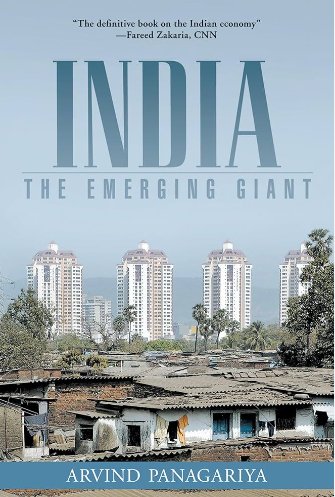Virendra Pandit
New Delhi: Summing up India’s economic surge, eminent economist Arvind Panagariya said on Friday that the South Asian country is set to become the world’s third-largest economy by 2026 when its GDP in current dollar terms will swell to USD 5 trillion in 2026 and USD 5.5 trillion in 2027.
“I am confident we are on the cusp of a new chapter in India’s history,” the former Vice Chairman of the National Institution for Transforming India (NITI) Aayog said.
The next two decades will see the fastest transformation in India’s history, given the large economic base already established and a high expected growth rate, he observed.
Dr. Panagariya, an Indian-American economist, is the Jagdish Bhagwati Professor of Indian Political Economy at Columbia University and the Director of Deepak and Neera Raj Center on Indian Economic Policies at the School of International and Public Affairs at Columbia University in New York City.
It is unlikely that the GDP of either Germany or Japan in current dollar terms will cross the USD 5 trillion mark in the next three years, he said while delivering the 18th C D Deshmukh Memorial Lecture, titled “India at 125: Reclaiming the Lost Glory and Returning the Global Economy to the Old Normal,” in Mumbai.
Japan will have to sustain a growth rate of 3.5 percent in current dollar terms to reach USD 5.03 trillion in 2027 from its 2022 level of USD 4.2 trillion, he said.
At the 4 percent annual growth rate, Germany’s GDP will rise from USD 4.4 trillion in 2023 to USD 4.9 trillion in 2026 and USD 5.1 trillion in 2027, he said.
“Given these estimates, how soon can the Indian GDP cross the GDPs of these two countries?.. that is the question,” Panagariya said.
India has grown at an annual average rate of 10.22 percent in current dollar terms.
“At this rate, India’s GDP in current dollar terms will reach USD 5 trillion in 2026 and USD 5.5 trillion in 2027. This means there are good prospects that India will become the world’s third-largest economy by the end of 2026, sooner than nearly all current predictions,” he said.
To realize its full potential, Dr. Panagariya said, India must take the steps necessary to help its economic units grow larger.
“Small habitations, small farms, and small enterprises are intimately linked. Reforms that will help the enterprises in industry and services grow larger will create job opportunities for the masses, which will, in turn, pave the way for workers to migrate from rural to urban areas,” he said.
Such migration will automatically increase land per worker in farming while also bringing more and more of the population to where development is, that is the urban areas.
“With the population becoming progressively concentrated in urban agglomerations, we will also see larger economic units replace some smaller ones in areas such as schools and colleges,” he pointed out.
Chintaman Dwarakanath Deshmukh was the first Indian to serve as the Governor of the Reserve Bank of India. During his term (1943 to 1949), the landmark Banking Companies Act of 1949, which was later renamed the Banking Regulation Act, came into force.

